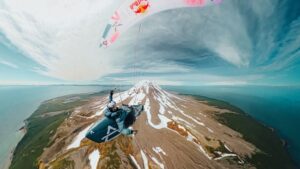Renowned Austrian Sportsman Paul Guschlbauer’s Tackles One of Alaska’s Most Active Volcanoes, Defeating Unpredictable Wind Conditions and Rugged Terrain.
August 5, 2024
Renowned sportsman Paul Guschlbauer has once again pushed the boundaries of adventure by conquering Augustine Volcano, one of the most active volcanoes in Alaska. Known for his exceptional performances in the Red Bull X-Alps and his unparalleled ability to uncover extraordinary locations, Guschlbauer’s latest achievement sets a new standard in the world of paragliding.

– Augustine Volcano, an imposing peak 284 kilometres from Anchorage, is situated on an uninhabited island off Alaska’s southern coast in Cook Inlet. The island is part of the Aleutian volcanic arc, a chain of volcanoes formed by the subduction of the Pacific Plate beneath the North American Plate.
– Standing at 1,252 metres, Augustine Volcano is one of the most awe-inspiring stratovolcanic summits. Built up by many layers of hardened lava, tephra, pumice, and volcanic ash, it is known for its explosive eruptions, producing pyroclastic flows, ash clouds, and lava domes.
– The Alaska Volcano Observatory (AVO) continuously monitors the volcano for signs of activity, using a network of seismographs, satellite imagery, and other geophysical instruments, and provides early warnings to ensure safety. Over the years, Augustine Volcano has demonstrated its volatility with significant eruptions in 1883, 1935, 1963-64, 1976, 1986, and most recently in 2006, each contributing to its reputation as one of Alaska’s most active volcanoes.
– Guschlbauer first spotted the volcano during a trip to Alaska and envisioned landing on the shoreline with a small aircraft. He said: “I saw the mountain from the mainland and thought that it would be incredible to fly there and land on the beach,” Guschlbauer recounts. “Even though none of my local friends knew the exact landing spots, I was confident I could manage the paraglide flight once I got there.”
– The journey required several years of meticulous planning and a deep understanding of both flying and paragliding under challenging circumstances. With the assistance of Ken, a mentor who taught him flying in Alaska, and Ken’s son Thomas, Guschlbauer gained crucial insights into the Alaskan terrain and weather dynamics. Despite the remote location and uncertain wind patterns, his expertise ensured he could wait for the perfect moment to catch rising currents of warm air, which are essential for gaining altitude and staying aloft during the flight.
– “My plan was to fly as high as possible with the plane and then conquer the mountain and fly down,” explains Guschlbauer. After landing on a suitable spot and climbing an additional 100 metres, the changing thermal conditions allowed him to paraglide from the summit. “Circling up and flying thermally from the volcano, surrounded by the sea, was an unparalleled experience. I never imagined I could land on the summit, but the opportunity was there, and I was ready. It was simply spectacular!”
– The mission required overcoming significant technical challenges, including identifying a safe landing zone on the rugged volcanic island. Utilising advanced tools like Google Earth for preliminary scouting, Guschlbauer and his team conducted exploratory flights to finalise their approach. The unpredictable wind patterns around the volcano demanded precise timing to ensure safe and effective paragliding opportunities.
– Paul Guschlbauer’s successful paragliding challenge on Augustine Volcano showcases his exceptional talent and sets a new benchmark in sports and exploration, highlighting the never-ending spirit of adventure and discovery inherent in human nature.
